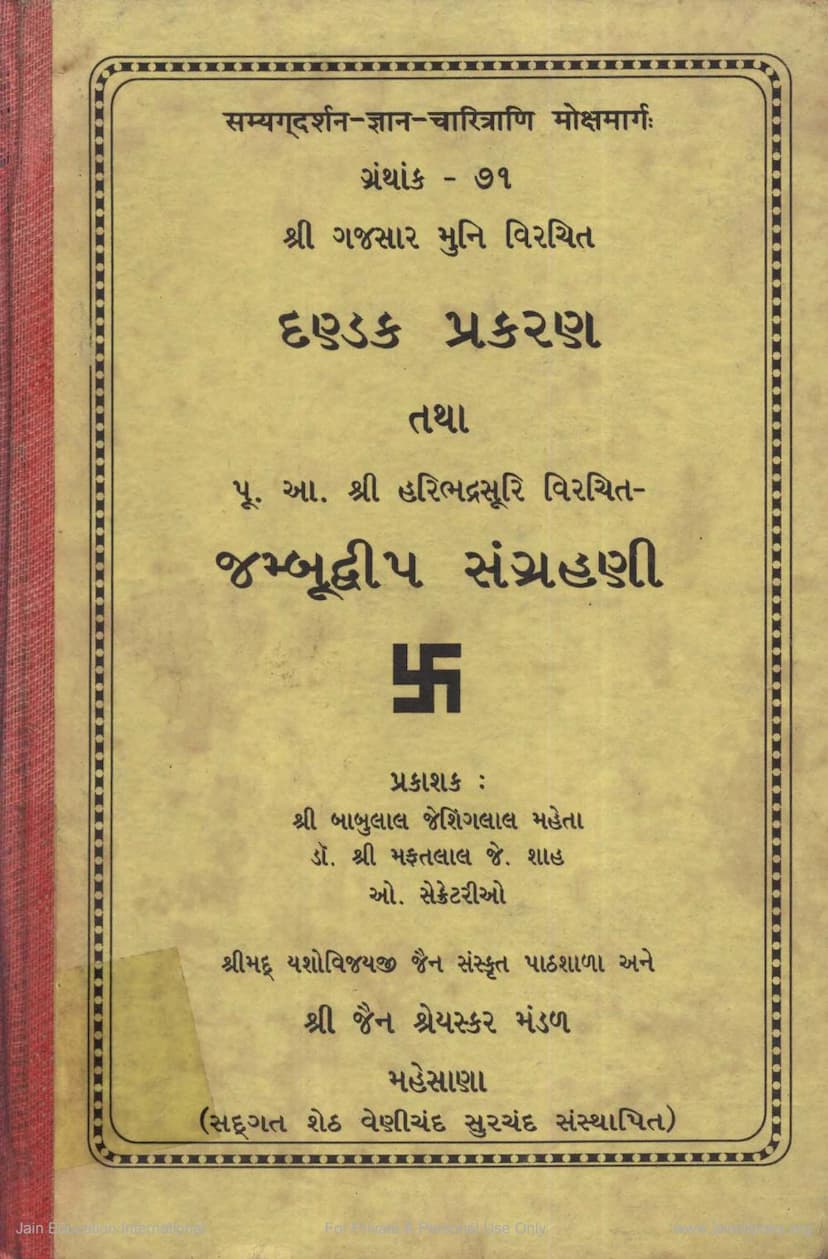Dandak Prakarana Tatha Jambudweep Sangrahani
Added to library: September 1, 2025

Summary
The provided text is a translation and commentary in Gujarati on two Jain texts: the Dandak Prakarana (Chapter on Dandakas) authored by Muni Gajsagar, and the Jambudweep Sangrahani (Collection on Jambudweep) authored by Acharya Haribhadrasuri. The book is published by Shri Jain Shreyaskar Mandal Mahesana.
Here's a comprehensive summary of the provided content:
Overall Purpose and Context:
- The book is presented as the 7th edition, aiming to provide accessible knowledge of core Jain philosophical and cosmological concepts.
- It emphasizes the importance of studying these scriptures for spiritual upliftment and liberation (Moksha).
- The introduction highlights the value of the "Dandak Prakarana" as a systematic study of qualities and powers within different types of souls, drawing parallels to modern sciences. It also discusses the significance of "Jambudweep Sangrahani" for understanding Jain geography (kshetra-vichar) and its relevance for spiritual study.
- A significant portion of the introduction is dedicated to addressing the apparent discrepancies between current scientific understanding and Jain cosmology, arguing that current science is incomplete and subject to change, thus cautioning against dismissing ancient scriptures based on temporary scientific theories. It encourages further research and a deeper study of Jain texts.
Key Texts and Their Content:
-
Dandak Prakarana (દંડક પ્રકરણ):
- Focus: This section explains the "Dandakas," which are twenty-four categories of living beings described in Jain scriptures. The text aims to simplify the complex concepts found in Agamic texts like the Bhagavati Sutra by organizing them into these twenty-four categories.
- Content: The "Dandaka Prakarana" details various aspects (called "dwaras" or "aspects") related to these twenty-four categories. These aspects cover a vast range of topics including:
- Body (Sharir): Different types of bodies (audarik, vaikriya, aharka, taijas, kaarman).
- Avagahana (Size/Stature): The physical dimensions of beings.
- Sanghana (Bone Structure): The formation and strength of skeletal systems.
- Sanjna (Consciousness/Instincts): Various types of instincts and drives.
- Samsthana (Body Shape): Different bodily forms.
- Kashaya (Passions): The four cardinal passions (anger, ego, delusion, greed).
- Leshya (Disposition/Coloration): The subtle karmic coloration of souls, categorized into auspicious and inauspicious types.
- Indriya (Senses): The five senses and their functions.
- Samudghata (Emanations/Expansion of Soul): Seven types of expansions of soul-matter, utilized by enlightened beings.
- Drishti (Viewpoint): Different philosophical perspectives (mithya, samyak, mishra).
- Darshan (Perception/Intuition): The ability to perceive general qualities of substances.
- Gyan (Knowledge): Various types of valid knowledge (mati, shrut, avadhi, manahparyay, keval).
- Agyan (Ignorance): Types of non-valid knowledge.
- Yoga (Activities): Mental, verbal, and physical activities.
- Upayoga (Application/Utilization): The application of senses, knowledge, and perception.
- Upapata (Birth): The process of reincarnation and where souls are born.
- Chyavan (Death): The process of dying.
- Sthiti (Lifespan): The duration of life in different states.
- Paryapti (Development/Completion): The stages of development of bodily, sensory, linguistic, and mental faculties.
- Kimāhāra (Diet/Intake): The direction from which beings draw sustenance.
- Sanjna (Cognition): Another mention of cognitive faculties.
- Gati (Destiny/Realm): The realm of existence (hellish, animal, human, celestial).
- Agati (Re-birth): The process of returning to a specific realm.
- Veda (Sexual Propensity): Male, female, and neuter tendencies.
- Alpabahutva (Relative Quantity): Comparisons of the number of beings in different categories.
- Structure: The text meticulously breaks down each of the 24 Dandakas (categories like hellish beings, celestial beings, sense-bound beings, humans, plants, etc.) and describes how these various "dwaras" apply to them. The text provides detailed explanations and comparisons, often in tabular or list formats.
-
Jambudweep Sangrahani / Laghu Sangrahani (લઘુ સંગ્રહણી):
- Focus: This section provides a simplified overview of Jain cosmology, particularly focusing on Jambudweep, the central continent of the Jain universe. It aims to make complex cosmological details understandable to a wider audience.
- Content:
- Cosmic Structure: Explains the concept of Loka (universe) with its three parts (upper, middle, lower) and the central placement of Jambudweep.
- Jambudweep Details: Describes Jambudweep as a vast, circular continent, approximately 100,000 yojanas in diameter.
- Central Mountain (Meru): Details the immense Meru mountain at the center, its height, and its divisions.
- Divisions of Jambudweep: Explains the division of Jambudweep into six regions (Khandas) and the surrounding oceans (Samudras). The regions are: Bharat, Mahāhima, Hari, Mahāhariv, Ramyak, Haimavat, and the central Mahavideh.
- Yearly Divisions (Varsha): Explains the divisions of Jambudweep into regions (Khandas) and the "Varsha" regions where humans reside.
- Mountains: Describes the prominent mountain ranges like Vaitadhya, Himavanta, Mahāhimavanta, Nishadh, Nilavanta, and Shikari, along with their dimensions and locations.
- Rivers: Details the major rivers like Ganga, Sindhu, Rakta, and Raktavati, their origins, lengths, and destinations.
- Cities and Territories: Mentions the existence of capital cities and territories associated with powerful beings.
- Other Cosmological Elements: Touches upon the mathematical calculations (ganita) related to dimensions and areas, the nature of celestial beings, and the structure of the universe.
Key Features and Contributions:
- Simplification: The primary goal is to make profound Jain teachings accessible, especially for beginners and younger students.
- Systematic Approach: The "Dandak Prakarana" presents a structured way to understand the vast classification of souls.
- Defense of Tradition: The introduction strongly defends the validity of Jain scriptures against modern scientific claims, advocating for a balanced and respectful approach to ancient knowledge.
- Mathematical Calculations: The "Jambudweep Sangrahani" section includes mathematical aspects of cosmology, explaining calculations for dimensions and areas.
- Scholarly Authorship: The book benefits from the contributions of esteemed Jain scholars and monks, highlighting a tradition of learning and preservation.
In essence, the book serves as a valuable educational resource for understanding fundamental Jain concepts related to the nature of souls, their classifications, and the structure of the Jain cosmos, presented in a way that bridges ancient wisdom with a modern perspective.